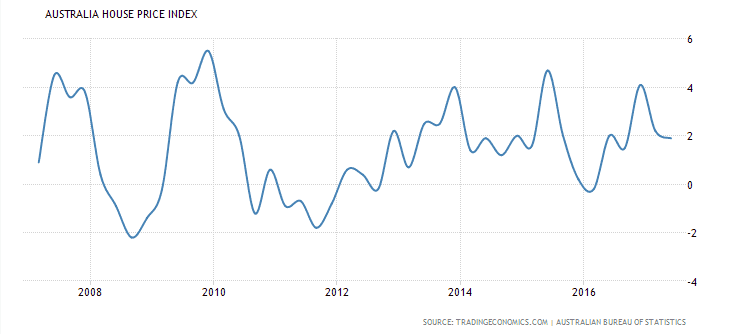Australian Dollar: Westpac say RBA to Only Raise Rates in 2020

The Reserve Bank of Australia is not likely to raise interest rates until 2020, according to research from Australian lender Westpac - if correct this could have significant implications for the Aussie Dollar's outlook.
Analysts at Westpac's research division have suggested the RBA might hold interest rates at current levels for up to three years.
The suggestion is at odds with consensus estimates which suggest as many as three 0.25% interest rate hikes could be delivered by the end of 2019. It also goes against the RBA’s own view that policy will need to tighten over time.
The Westpac view contradicts recent analysis from ANZ Bank’s David Plank who thinks the RBA will raise interest rates twice in 2018 alone, in order to curb lending.
If realised, Westpac’s forecasts bode ill for the Australian Dollar which is positively correlated to interest rates.
Westpac’s Bill Evans, however, argues a lack of upwards pressure on wages will limit inflation and make any moves by the RBA unlikely until after 2019.
“The Reserve Bank expects wages growth to increase over the forecast period. A major puzzle for central banks globally has been the limited response of wages to stimulatory monetary policies since the GFC. Despite these policies in the US; Germany; the UK and Japan driving labour markets to near or full employment, wages have failed to respond,” says Evans, who thinks the same dampening effect will hamper wage growth in Australia.
The difference in opinion is due to Westpac’s growth forecasts, which are considerably lower than those of the RBA.
“The RBA expects growth in Australia to be 3.25% in 2018 and 3.5% in 2019 (above trend of 2.75%). Westpac expects a below trend pace of 2.5% in both years,” adds the economist.
Inflation too is likely to undershoot official forecasts, says Evans:
“The RBA is also forecasting 2% underlying inflation in 2017 and 2018 (bottom of target band) to be followed by 2.5% in 2019,” and yet in reality, “Underlying inflation is currently running at 1.8% (to June) and the upcoming revised weights are likely to reduce annual underlying inflation by 0.2-0.3%.”
Evans notes how, whilst unemployment is Australia is relatively low at 5.6%, it is still not quite at the estimated level of full-employment of 5.0% so there remains some slack in the economy.
There is also a higher-than-expected underemployment level of 8.8% giving, a total excess capacity of 14.5%.
“Given the global lessons on the structural wages outlook, it seems unlikely that wages in Australia (where spare capacity is higher than in these other developed economies) will lift significantly even in the medium term,” says Evans.
His analysis contrasts with that of ANZ who were a lot more hawkish in their recent report.
Get up to 5% more foreign exchange by using a specialist provider by getting closer to the real market rate and avoid the gaping spreads charged by your bank for international payments. Learn more here.
ANZ are More Bullish
ANZ’s David Plank says the unusually high levels of household debt prevalent in Australia are the reason the central bank will raise rates twice in 2018.
Borrowing is too cheap and this is leading to financial stability risks as people continue increasing their debts.
The only way to curb this will be via interest rate rises.
“We think a negative real cash rate will encourage a continued build-up in household debt. We don’t think macroprudential policy will be able to counter the impact of continued low rates. Indeed, one of the reasons we have revised up growth for 2018 is that we think the housing market (both construction activity and prices) is proving more resilient than we expected,” said Plank.
The two economist’s views diverge most sharply in relation to the contentious housing market, which has threatened to overheat in recent years.
Plank sees the threat as still very real despite the introduction of macroprudential policies which make lending criteria stricter and were introduced by the RBA to counteract the housing bubble.
However, Evans is less concerned about the housing market, saying that the macroprudential policies have worked at cooling the market and the RBA does not therefore need to raise rates to curb mortgage lending, anyway.
“The four majors (90% of the mortgage market) have been raising investor and interest only mortgage rates while applying tighter lending guidelines. House price inflation is slowing and regulators are unlikely to have any patience with a reversal of this trend,” said Evans.
He cites a slowdown in house price inflation in Sydney as an example:
“To that point, six month annualised house price inflation (CoreLogic data) in Sydney has slowed from 22.4% in January to 4.8% in August. We observed a similar response to macroprudential policies in 2015/16 when six month annualised house price inflation slowed from 25% (July 2015) to -4.4% (April 2016).”
“Housing activity is also slowing despite a steady cash Rate,” concludes Evans.
The most recent house price data in Australia is for the second quarter of 2017 and shows a steady average rise of 1.9% in house prices compared to the previous quarter, and a very strong annual rise.
The average residential dwelling price stood at AUD 679,100. On a yearly basis, house prices grew by 10.2 percent, the same as in the previous quarter.

It was the fifth straight quarter of increase in house price index, as prices continued to increase in most cities:
Sydney (2.3 percent from 3.0 percent in Q1); Melbourne (3.0 percent from 3.1 percent in Q1); Brisbane (0.6 percent after a flat reading in Q1); Adelaide (0.8 percent from 1.5 percent); Hobart (1.8 percent from 3.4 percent); and Canberra (1.3 percent from 2.8 percent).
In contrast, prices fell in Perth (-0.8 percent from -1.0 percent in Q1) and Darwin (-1.4 percent from -0.9 percent).




